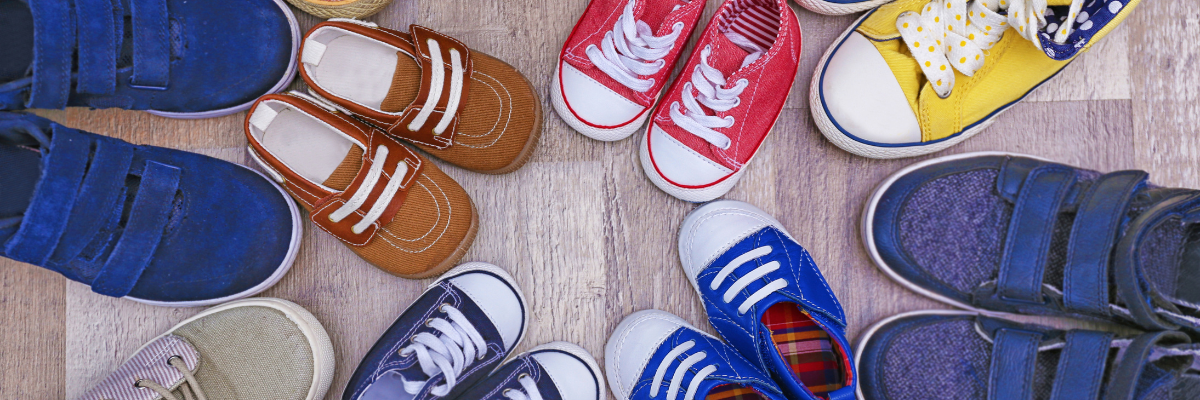Choosing the right footwear for children can be a daunting task for parents, especially when considering the importance of comfort, support, and proper development. As kids grow, their feet undergo significant changes, and the right shoes can help promote healthy foot development, prevent injuries, and enhance overall mobility. Here’s a guide to help you find PT-approved footwear for your little ones.
Why Footwear Matters – Qualities of Good Kids Shoes That PT-Approved
Children’s feet are still developing, making it crucial to provide them with shoes that offer proper support while also allowing room to grow. Poor footwear can lead to a variety of issues, including flat feet, overpronation, and discomfort. Physical therapists often emphasize the following features in kids’ shoes:
- Arch Support: Proper mid-foot arch support is essential to promote natural foot development and prevent conditions like flat feet. Look for a shoe that flexes at the toe vs. mid shoe when you bend it.
- Flexibility: Shoes should allow for natural movement. A shoe that has a flexible toe/forefoot region enables kids to engage in physical activities without restriction.
- Adequate Cushioning: Ample cushioning helps absorb shock during activities, reducing the risk of injuries.
- Room for Growth: Kids grow quickly, so it’s important to choose shoes that allow for a little extra room without being too loose. A shoe with a wide toe box allows for extra growth and room for their toes to splay, which helps to provide a wider base of support and improve balance!
- Breathability: Shoes made from breathable materials help keep feet dry and comfortable, reducing the risk of blisters and fungal infections.
- Adjustable closure: Shoes with adjustable closures can be adjusted for a sung but comfortable fit. This helps provide the ideal support during movement without worrying about their foot sliding around in the shoe. Look for a shoe with velcro or laces/straps that can be adjusted for the perfect fit.
- Sturdy/solid heel cup: Shoes that have a sturdy heel cup provide solid support and stability for your little one’s ankles. In addition, they help to promote proper leg alignment while walking, running, and during general play activities! Look for a shoe that when you push on the back of the shoe it doesn’t collapse in.
Brands that offer PT-approved footwear options:
1. New Balance
New Balance offers a variety of children’s shoes that are known for their excellent arch support and cushioning. Models like the Kids Rave Run v2 are lightweight, have moderate arch support for higher impact activities, and have a wide toe box that give the feet plenty of space!
2. Saucony
Saucony’s Kid’s Cohesion line features good arch support and a breathable upper. They’re designed for running and play, offering stability without sacrificing flexibility.
3. Asics
Asics shoes are known for their GEL cushioning system, which provides excellent shock absorption. The Gel-Contend series is a great choice for everyday wear and sports.
4. Stride Rite
Specializing in children’s footwear, Stride Rite offers shoes that prioritize foot health. Their shoes often feature rounded toes and flexible soles to promote natural foot movement.
5. Pediped
Whether you’re looking for sandals, sneakers, or boots, Pediped provides a variety of shoes that promote healthy foot development. Their Originals, Grip ‘n’ Go, and Flex designs have been officially recognized by the American Podiatric Medical Association (APMA) as being beneficial for children’s growing feet!
6. Cat and Jack and Walmart also have various cost effective options that provide adequate fit and stability. Use the tips above to find shoes that fit these criteria!
More tips for Choosing the Right Shoe
- Measure Feet Regularly: Kids’ feet can grow rapidly, so measure them every few months to ensure a proper fit.
- Try Shoes on in the Afternoon: Feet can swell throughout the day, so fitting shoes later in the day can ensure a better fit.
- Check the Fit: Compressive footwear may cause weakness, deformity, and mobility loss, so you want to ensure there’s about a thumb’s width of space between the end of the shoe and the longest toe. The heel should fit snugly without slipping.
- Look for Quality Materials: Choose shoes made from durable and breathable materials, such as leather or mesh, to ensure longevity and comfort.
- Involve Your Child: Allowing kids to choose their shoes can make the experience fun, but guide them toward options that meet their physical needs.
***Special Tip for Little Ones: These recommendations are mostly for experienced walkers. If you have a baby who is just starting to learn to stand and walk, barefoot is best so they can gain strength and balance. If a new/early walker needs shoes for daycare or outdoor use, look for a flexible option with a wide toe box that fits securely on the foot (adjustable closure) without sliding off.***
How Can Carolina Therapy Connection Help?
Investing in the right shoes for your children is crucial for their foot health and overall well-being. With the recommendations from physical therapists and a focus on supportive, flexible, and well-fitting options, you can help your little ones stay active and comfortable. Remember, the right shoe today can lead to healthier feet tomorrow!
Written By: Anna Seguin, PT, DPT

